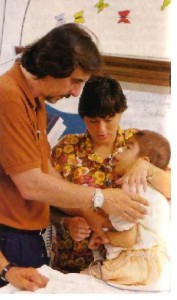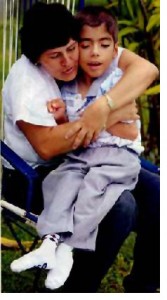Women’s Day Magazine
WRITTEN ON: SEP 25 2019
A heartbreaking plea on the internet led an international team of doctors, including one from Australia, to rescue a child from hell.
When Israeli doctor Andre Waismann turned on his computer and saw a desperate plea for help from a Costa Rican doctor, little did he know that history was in the making. With the help of an Australian doctor, Dr Waismann cured six-and-a-half-year-old Endriss Guzman of morphine addiction, saving him from almost certain death.
Now Australian doctors are introducing the miracle treatment – rapid detoxification – here in the hope that it will end the suffering of thousands of heroin addicts.
Endriss was a patient of Dr Julia Matamoros at her tiny hospital just two hours north of San Jose. For the past five years of his life, the youngster had been a junkie, his mother forced to inject her only son four times a day to stave off relentless cravings and withdrawal.

As a toddler, he was given up for dead following a brain tumour operation. Given repeated and massive doses of morphine and left to die, he confounded doctors by beating the cancer. But he became a slave to the same opiates that destroy the lives of heroin addicts.
After years of injections, Endriss was hospitalised two months ago after his mother, Mercedes, 30, could no longer find viable veins in which to inject the prescribed six-hourly shots of morphine.
“Endriss was in terrible condition”, Dr Matamoros told Woman’s Day. “He weighed just 13 kilos – about half of what he should have. The original brain operation and the years of constant drug use had exacted a devastating toll.
“Endriss couldn’t talk. He couldn’t walk. His limbs were wasted and contorted. He hadn’t tasted food since he was operated on as a 14-month-old baby. Instead, he was fed by a nasal-gastric tube.
“We slowly attempted to wean him off the morphine, but he had been given so much initially that his addiction was just overwhelming and beyond us to reverse.
“It was not the brain surgeons’ fault. They truly believed he would die despite the tumour’s removal, so addicting him to morphine to stop the pain was of little consequence as he would die anyway.”
But Endriss survived.
“And we were left with the result,” says Dr Matamoros. “A boy who spent most of his time lying semi-conscious in his bed, racked with the pain associated with opiate withdrawal. A mother who had no choice but to keep injecting her son with the very drug that was stupefying and wasting him.”
Several weeks ago, Dr Matamoros sent out a “message in a bottle” via the Internet, pleading for someone to help save Endriss’s life. She contacted doctors around the world working in the drug treatment field, desperately seeking advice;
“The only one to answer was Dr Andre Waismann,” she says. “He not only offered advice, but asked me to send him the boy’s case history. He then rang back and offered to come here, assemble a medical team who could assist and learn from him, and to operate on Endriss free of charge.
“I cried a lot that day. Endriss finally had a chance. I knew little about Dr Waisman and his work, but I knew we had to take a chance.”
In fact, Endriss would become the first child addict in the world to be cured by Israeli doctor Andre Waismann’s rapid detoxification treatment. Often controversial, his treatment centres on the patient being detoxified under light anaesthesia while the so-called opiate antagonist drug, naltrexone, is administered.
The treatment effectively blocks the cravings which normally undermine traditional detox procedures, causing up to 95 percent of addicts to go back on drugs.
Brazilian-born Waismann, 39, plays down the significance of the procedure he carried out in Costa Rica with the help of Sydney doctor Yugan Mudaliar.
“This was by far the most complex and delicate case I have ever undertaken,” he said after the successful five-hour procedure in the San Carlos Public Hospital.

“But there is no magic involved. I am telling anyone willing to listen or prepared to take the time to understand – heroin addiction, morphine addiction, methadone addiction are all identical central nervous system disorders that are reversible. Totally! Almost instantly!
“Endriss will never use again. He is cured. Anyone can be cured.
“If you want proof, look into his eyes and into his mother’s – the woman who has had to hit him up four times a day for five years to stave off his screams for the drug.
“Now, because of this case, I can confidently proceed to where the greatest challenge awaits – treating heroin-addicted babies with something other than the methadone doctors shoot into them. I know it can be done – Endriss has proved that.”
Endriss Guzman’s story is all the more incredible because of the bizarre and unlikely circumstances that led an Israeli, an Australian and a small dedicated team of Costa Rican doctors to attempt such a difficult procedure. Had it failed, they would have been instantly condemned in the eyes of, the medical world and, more particularly, provided vital ammunition to Dr Waismann’s outspoken detractors.
Dr Mudaliar, the head of intensive care at Sydney’s Westmead Hospital, was bowled over by the operation he assisted in and by what he saw on previous visits to the Tel Aviv clinic.
“We have all witnessed a wonderful event that must now be reported through the medical journals of the world,” he says. “There is no doubt in my mind this boy is cured – and it is not a word I use lightly.”
Dr Mudaliar was one of four Sydney doctors who journeyed to Tel Aviv several months ago to investigate the Israeli doctor’s treatment. The team observed 14 Australian heroin and methadone addicts undergo Dr Waismann’s accelerated opiate detoxification treatment in Tel Aviv’s Megama Centre.
“All went to sleep as addicts and woke up the next morning no longer addicted,” said Dr Mudaliar. “We know this because we meticulously and scientifically followed the patients through every step. We are so convinced that we will clinically trial this treatment on Australian addicts within a matter of months.”
For Dr Matamoros, a palliative care and pain management expert attached to the San Carlos Hospital, Endriss’s treatment and cure was a revelation.
“We saw the future of medicine. And we surely saw the beginning of the end of incurable opiate addiction.”
But the greatest relief and joy was felt by Endriss’s parents and his two sisters. They visited the youngster the morning after his treatment, and shed many tears, but for the first time in five long years, they were tears of joy. “We have him back,” dad Lidier says. “Our baby boy is back.” No-one knows if Endriss will ever walk or talk again, due to the brain damage caused by the tumour and the operation to remove it. His limbs are withered, his hands twisted and contorted. His general physical condition is poor due to the years of drug intake and lack of adequate’ nutrition. But his progress in just the first 72 hours alone suggests that anything is possible for this brave little boy. Within a day, he was eating food for the first time: He was smiling, his eyes alert and sparkling. And there were no screams of withdrawal.
Mercedes Guzman, tears rolling down her face, embraced Andre Waismann. As she did so, she gently placed something in the doctor’s hand before returning to the bedside to be with her son. Dr Waismann stared back and smiled knowingly. In his hand were the syringe and vials of morphine that Mercedes had kept with her every hour of every day since 1992. Dr Waismann threw them into the bin – no-one needs them any more!
